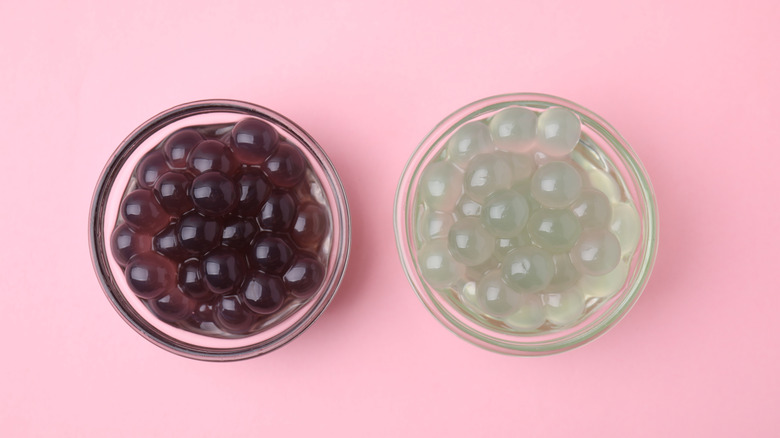The Old-School Dessert That Remains Controversial Today
Foods with strong detractors, like anchovies or pineapple (on pizza, that is), are common enough. But perhaps no food has remained as controversial as tapioca pudding. What's your first memory of the bouncy dish? Was it while you were stuck in a hospital bed on a no-solids diet? Was it a plain pudding, or was it something ornate, like a pearl tapioca pudding brûlée with boiled peanuts? Love it or not, tapioca pudding is truly a contentious old-school dessert that suffers from a poor reputation, which determined cooks and Internet denizens have been trying to rehabilitate for years.
Most people's issue with tapioca pudding is the texture. Made incorrectly, this dish can be overwhelming with its thickness, which is then compounded by the chewy tapioca pearls. Their gelatinous consistency increases the overall gluey mouthfeel, which no amount of sweet, rich flavor can overcome. Made properly, though, it's a warm, creamy bowlful, where the tapioca pearls add interest to each bite.
If you expected the dish to hail from the mid-20th century (when its popularity was at its height), you were only off by about 150 years. Tapioca pudding recipes featured in 18th-century cookbooks, but it wasn't until the late 19th century that a formalized American recipe made its appearance. This originates with Bostonian Susan Stavers, who — the legend goes — created a comforting dish for a convalescing boarder, out of cassava root the sailor had brought back.
After Stavers began peddling her creation door-to-door, John Whitman, a publisher at a local newspaper and grocer, purchased the recipe and founded the Minute Tapioca Company. While the company only lasted until 1967, Stavers' concoction would go on to become one of the most polarizing dishes across the American culinary landscape, even today every day.
You might recognize tapioca pearls from boba
Tapioca has historically appeared in the cuisines of African and Asian countries, with the American version hailing from South America, specifically Brazil. What do these regions have in common? It's their tropical climate, where the plants that make tapioca flour, and therefore tapioca pearls, thrive; in South America, they come from the cassava root, and in Africa and Asia, they come from the sago palm. While people on the American continents, and indeed, in Nepal and India, used the tapioca pearls traditionally in their puddings (you ought to try them in your oatmeal, too), the Taiwanese began putting them in their milk teas to create boba or bubble tea.
Naturally, boba tea spread to the U.S., and while it was slow-going at first, served mainly in Taiwanese eateries, bubble tea shops began to open in the L.A. area, then up and down California, and finally across the country. And the stars of the show, those chewy bobas that jiggle so satisfyingly at the bottom of the cups and give our teeth something satisfying to sink into while enjoying a sweet beverage (you should, by the way, chew up boba instead of swallowing them whole)? They're the very same tapioca pearls that have long existed in pudding recipes for centuries.


